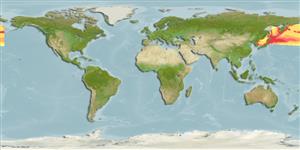>
Perciformes/Cottoidei (Sculpins) >
Liparidae (Snailfishes)
Etymology: Squaloliparis: Latin, squalidus = pale, weak + Greek, liparis = fat; dentatus: Named for its unusual dentition.
Environment: milieu / climate zone / depth range / distribution range
Ökologie
seewasser bathypelagisch; tiefenbereich 120 - 900 m (Ref. 51661). Deep-water
Northwest Pacific: off Okhotsk coast of Hokkaido, Japan and off western coast of Kamchatka.
Size / Gewicht / Alter
Maturity: Lm ? range ? - ? cm
Max length : 45.0 cm FL Männchen/unbestimmt; (Ref. 115020); max. veröff. Gewicht: 3.2 kg (Ref. 115020)
Life cycle and mating behavior
Geschlechtsreife | Fortpflanzung | Ablaichen | Eier | Fecundity | Larven
Kido, K., 1988. Phylogeny of the family Liparididae, with the taxonomy of the species found around Japan. Mem. Fac. Fish. Hokkaido Univ. (35)2:125-256. (Ref. 28160)
IUCN Rote Liste Status (Ref. 130435: Version 2024-2)
Bedrohung für Menschen
Harmless
Nutzung durch Menschen
Tools
Zusatzinformationen
Download XML
Internet Quellen
Estimates based on models
Preferred temperature (Ref.
123201): 0.5 - 3.6, mean 1.5 °C (based on 128 cells).
Phylogenetic diversity index (Ref.
82804): PD
50 = 1.0000 [Uniqueness, from 0.5 = low to 2.0 = high].
Bayesian length-weight: a=0.01622 (0.00637 - 0.04128), b=3.07 (2.84 - 3.30), in cm total length, based on LWR estimates for this (Sub)family-body shape (Ref.
93245).
Trophic level (Ref.
69278): 3.7 ±0.6 se; based on size and trophs of closest relatives
Widerstandsfähigkeit (Ref.
120179): mittel, Verdopplung der Population dauert 1,4 - 4,4 Jahre. (Preliminary K or Fecundity.).
Fishing Vulnerability (Ref.
59153): Moderate vulnerability (40 of 100).
